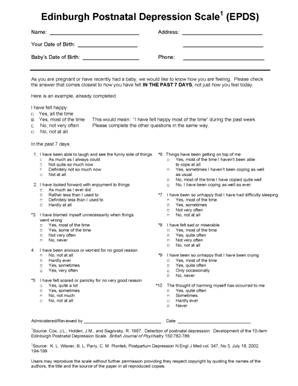What are the signs of postnatal depression? How can I get rid of my postnatal depression? When to screen for postpartum depression? What is mandated screening for postpartum depression? Postpartum depression is the most common complication of childbearing.

The 10-question Edinburgh Postnatal Depression Scale (EPDS) is a valuable and effici ent way of identifying patients at risk for “perinatal” depression. The American College of Obstetricians and Gynecologists (ACOG) recommends screening for postpartum depression (PPD) with a validated tool, which may reduce the duration or severity of depressive symptoms. Using a validated tool. ACOG recommends using a validated screening tool. The purpose and intent of the tool is to identify women at risk to reduce to the severity and the length postpartum depression though early and effective treatment.
ABSTRACT: Perinatal depression , which includes major and minor depressive episodes that occur during pregnancy or in the first months after delivery, is one of the most common medical complications during pregnancy and the postpartum perio affecting one in seven women. Screening for Perinatal Depression. It is important to identify pregnant and postpartum women with depression because untreated perinatal depression and other mood disorders can have devastating effects. EDINBURGH POSTNATAL DEPRESSION SCALE (EPDS) The EPDS was developed for screening postpartum women in outpatient, home visiting settings , or at the –week postpartum examination.
It has been utilized among numerous populations including U. Spanish speaking women in other countries. Symptoms are present for most of the day and last for at least weeks. Women experience a combination of low moo fatigue, anxiety,. Learn about a depression medication and how it may help treat depression. Find treatment resources as well as safety and clinical data pertinent to doctors.
Online Therapy with a Licensed Counselor. Available Anytime, Anywhere You Need It. The Time is Now to Put Yourself First. For MDD treatment options. Also take depression screening test here and take bipolar disorder test.

If you want to check your anxiety level then take it here. In pregnancy most of women will become anxious of giving birth to child and these types of baby blues are normal. Other screening tools have been used to screen for postpartum depression.
This is not intended to provide a diagnosis – only trained health professionals should do this. It also has adequate sensitivity and specificity to identify depressive symptoms in the antenatal period and is useful in identifying symptoms of anxiety. The scale consists of short statements. Find information about an MDD treatment for your patients. More than one in new mothers is thought to experience significant postpartum depression.
A postpartum depression screening can help find out if you have this condition. Public health nurses will carry out a screening for postnatal depression. Professional support and counselling. Your GP may refer you to the Primary Care Psychology Services.
Drug treatment for postnatal depression usually. The Edinburgh Postnatal Depression Scale (EPDS) is the most well-known, validated instrument for screening pregnancy-related depression. It has questions, is free, is relatively easy to score, and can be completed in less than minutes by the mother.
Unfortunately, many barriers make perinatal depression screening difficult to carry out in the ob-gyn practice setting. The goal of this toolkit is to alleviate barriers and implement routine perinatal depression screening into practice. In spite of this, the American College of Obstetricians and Gynecologists’ Committee Opinion on screening for perinatal depression recommends the utility of screening tools that are shorter and that take less time to complete, such as the Edinburgh Postnatal Depression Scale and the Patient Health Questionnaire-9.
Clinicians might consider this when choosing a screening tool that best fits into the scope of their practices. Early formal screening for postpartum depression is not only best practice, but also highly feasible with a brief structured screening measure. The EPDS (Appendix 1) is a self-administered screening tool which can be used to give an indication of the likelihood of postnatal depression. The score obtained can signal the need for further assessment.

Although the EPDS was defined to screen for postnatal depression it can also be used in the antenatal period.
No comments:
Post a Comment
Note: Only a member of this blog may post a comment.